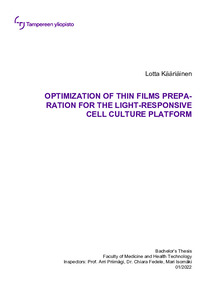Optimization of thin films preparation for the light-responsive cell culture platform
Kääriäinen, Lotta (2022)
Kääriäinen, Lotta
2022
Bioteknologian ja biolääketieteen tekniikan kandidaattiohjelma - Bachelor's Programme in Biotechnology and Biomedical Engineering
Lääketieteen ja terveysteknologian tiedekunta - Faculty of Medicine and Health Technology
This publication is copyrighted. You may download, display and print it for Your own personal use. Commercial use is prohibited.
Hyväksymispäivämäärä
2022-01-20
Julkaisun pysyvä osoite on
https://urn.fi/URN:NBN:fi:tuni-202201031009
https://urn.fi/URN:NBN:fi:tuni-202201031009
Tiivistelmä
Tissues are constantly changing microenvironments composed of cells and the extra-cellular matrix (ECM). This dynamic environment regulates the cell functions, such as differentiation and migration. Traditional 2D cell culture platforms lack the natural, dynamic characteristics of tissue, which alters the behaviour of cultured cells compared to the behaviour of cells living in their natural microenvironment. Thus, stimuli-responsive, dynamic cell culture platforms are needed for better mimicry of natural tissues in vitro.
Isomäki et al. have presented a light-responsive cell culture platform for reversible cell guidance. The platform consists of a thin spin coated film of azobenzene-based Disperse Red 1 -glass (DR1-glass) covered with a thin polydimethylsiloxane (PDMS) coating. This bilayer structure can be reversibly photopatterned, and the surface topography of the material is used for guiding focal adhesion alignment and orientation of epithelial cells cultured on top of the platform. However, the thin DR1-glass films are inhomogeneous, and the film thickness varies between separate films and at different spatial locations inside a single film. Such differences affect the optical properties of the material. Hence, the DR1-glass film preparation protocol needs to be optimized for reliable comparison and interpretation of the data collected from the platform. Additionally, the optimization is inevitable for prospective commercialization of the platform.
The aim of this research was to optimize the DR1-glass thin films preparation protocol to produce high-quality and reproducible films for light-responsive cell culturing. The optimization included the solvent used for DR1-glass films, preparation of the spin coating solution and the actual sample preparation by spin coating. As a result of the optimization, the appearance of the films was massively improved, and the material aggregates and swirls on the films were eliminated. The maximum standard error of the absorption spectra of the films decreased by over 90 %. The optimized DR1-glass films are now uniform and the sample preparation protocol reproducible. Accordingly, these high-quality films can be used in research of cell-material interactions and cell behaviour in dynamic environments.
Isomäki et al. have presented a light-responsive cell culture platform for reversible cell guidance. The platform consists of a thin spin coated film of azobenzene-based Disperse Red 1 -glass (DR1-glass) covered with a thin polydimethylsiloxane (PDMS) coating. This bilayer structure can be reversibly photopatterned, and the surface topography of the material is used for guiding focal adhesion alignment and orientation of epithelial cells cultured on top of the platform. However, the thin DR1-glass films are inhomogeneous, and the film thickness varies between separate films and at different spatial locations inside a single film. Such differences affect the optical properties of the material. Hence, the DR1-glass film preparation protocol needs to be optimized for reliable comparison and interpretation of the data collected from the platform. Additionally, the optimization is inevitable for prospective commercialization of the platform.
The aim of this research was to optimize the DR1-glass thin films preparation protocol to produce high-quality and reproducible films for light-responsive cell culturing. The optimization included the solvent used for DR1-glass films, preparation of the spin coating solution and the actual sample preparation by spin coating. As a result of the optimization, the appearance of the films was massively improved, and the material aggregates and swirls on the films were eliminated. The maximum standard error of the absorption spectra of the films decreased by over 90 %. The optimized DR1-glass films are now uniform and the sample preparation protocol reproducible. Accordingly, these high-quality films can be used in research of cell-material interactions and cell behaviour in dynamic environments.
Kokoelmat
- Kandidaatintutkielmat [7047]
